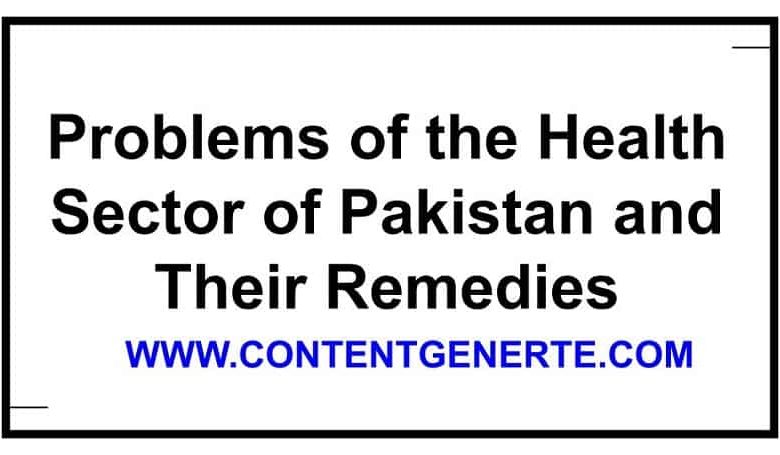
This post discusses the problems related to the health sector of Pakistan. It also suggests remedies to overcome the challenges in the field of health.
Contents
What are the main problems related to the health sector of Pakistan?
Problems related to the health sector of Pakistan include low budgetary allocation, lack of doctors, poor physical infrastructure, population explosion, fake and expensive medicines, lack of paramedical staff, quackery, etc.
1. Low Budgetary allocation
According to World Health Organization’s standard, a country should spend at least 5% of its GDP on the health sector. The share of GDP that most of the developed nations allocate for health is 8%. However, for third-world countries like Pakistan, 8% of GDP allocation for health remains to be a dream. Pakistan allocates less than 3% of its GDP to the health sector which relatively a very small amount to meet the health needs of an increasing population.
Suggested remedies
The government in Pakistan needs to make health one of its top priorities in policymaking. Health is linked with the economic development of a country. The current allocation of funds for the health sector is negligible keeping the huge population of the state. Therefore, the successive governments should allocate at least 7 to 8% of their GDP to the health care sector of the country to ensure a healthy society.
2. Lack of doctors and hospitals
According to Kumar and Bano (2017), Pakistan is listed as one of 57 countries with critical health. The doctor-to-patient, doctor-to-nurse, and nurse-to-patient ratios in Pakistan were 1:1300 and 1:2 and 1:20 respectively. This shows a critical shortage of human resources in the health sector of Pakistan. According to WHO, doctor to patient and doctor-to-nurse ratio should at least be 1: 100 and 1:4 ratio respectively.
3. Poor Physical infrastructure
The infrastructure of Basic Health Units (BHU’s) and Rural Health Centres (RHC’s) in Pakistan is very poor. As a result majority of people are reluctant to use public health services. This leads to the diversion of people to the hospitals providing tertiary care (Kurji et al., 2016).
The hospital lacks important health facilities i.e. X-ray, MRI, Ultrasound, operation theatres, ventilators, and other facilities. The number of hospitals and health care units is so small that it cannot meet even the basic health needs of an increasing population. Similarly, the distance, poor road conditions, and absence of ambulances hinder access to health services in times of emergency.
4. Weak human resources
The overall health sector faces an acute shortage of trained and skilled workforce across different levels of health care i.e. primary, secondary, and tertiary. The staff of the BHUs often exhibit an attitude and behavior characterized by a lack of professionality, politeness, and gentle dealing. Those who visit public sector Basic Health Units often find themselves caught in a nightmare. This has led to the underutilization of the public health sector in the country.
How to develop human resources in the health sector?
In Pakistan, the development of human resources in the health sector does not match their actual demand. It is rather far away from the actual demand. Therefore, it’s high time to put measures in place given the principle of the Demand-Supply Mechanism.
i. Inservice training and workshops
To produce a quality workforce for the health sector, the quality of medical and allied education both in the public and private sectors needs to be looked into. In-service refresher training/workshops need to be conducted to enhance skills at individual and institutional levels. Medical colleges and universities should offer advanced Nursing courses.
ii. Establishment of more medical colleges and universities
Similarly, there is a dire need to establish more medical colleges to offer admission for more students in the medical discipline. This will help to increase the number of doctors, nurses, and professional health practitioners in the country. Moreover, the government should give scholarships to the students both on a need and performance basis to help poor students pursue their careers in medicine.
4. Population growth
Pakistan the sixth most populous country in the world. The decline in population growth rate has been slow. The current population growth rate of 2% is still very high. This high growth rate makes it difficult for the authorities to cater to the increasing needs of health.
Suggested Remedies
Pakistan’s population is increasing with an enormous growth rate. according to different estimates, Pakistan would the fourth populous country by 1950. The problem of overpopulation compels the nation to compromise the overall health status of the people.
Serious measures need to be put in place to check the high population growth rate trend in Pakistan. Firstly, the government should frame a policy to aware and encourage people to practice family planning. Promotion of cooperation with mainstream and social media outlets, religious scholars, community notables, etc. Schools and colleges can be instrumental in making creating a family planning-friendly environment in the country.
Moreover, underage marriages continue happening despite laws discouraging this practice. Hence. the government and its sub institutions like police need to take practical steps should stop early marriages to decrease the reproductive span.
5. Uncontrol Prices of the medicines.
Thus the ineffective price control regulation is a major concern of the health sector in Pakistan and developing countries. In Pakistan, 64% of health expenditure is borne by patients from their pocket is unaffordable due to the high prices of medicines (Saeed et al. 2017 as cited in JD et al. 2002). Thus the uncontrolled prices are one of the major obstacles for inadequate access to medicines, of both simple and essential nature (Saeed et al. 2017 as cited in JD et al. 2002). Similarly, the treatment and related services are also too expensive to bear for the poor.
The government-funded system is relatively considered to be less expensive but in reality, it is a myth. When attending a public sector Basic health unit, a patient has to bear various costs i.e. charges of medication and other consumables. More than 35% of the population in Pakistan lives under the poverty line. These people do not receive any care and are caught in the ‘medical poverty trap’.
Suggested remedies
Health insurance for the poor and availability of medicines at hospitals.
- There should be a clear pricing formula to considerably overcome the issue of affordability. Currently, price determination depends upon the prices of the inputs. This results in wide price variability and was thought to also create opportunities for collusion to obtain high prices.
- Provide subsidies for drug companies through a proper monitoring mechanism for the production of low-cost medicines.
- Should improve procurement practices, make them more transparent and competitive to rationalize the spending in alignment with patient consumption and morbidity data (Zaidi et al. 2013).
- exemption on electricity, gas, and taxes to pharma companies. exemption in import duties.
- Health coverage systems for the poor like the Ihsaas program, etc.
7. Quackery
In Pakistan, there is no dearth of fake doctors and medical practitioners. The quacks pretending themselves as doctors play with the health and life of the poor people. Zubair (2017) has found that most people in Pakistan consider quacks an important part of s a necessary part of society. They are an ultimate need due to less number of registered medical practitioners as per the requirement of the population.
Remedial measures
To counter the issue of quackery in Pakistan, Zubair (2017) suggests the government to ensure:
1. institutions produce a good number of genuine medical practitioners as per the demand of society.
2. presence of registered medical practitioners at Health care units round the clock in villages and remote areas;
3. establishment of more and more health care units in areas with low-income people;
4. make free the medicines and presence of genuine medical practitioners and paramedical staff;
5. enhancement of the capacity of the medical practitioners concerning patient dealing and treatment.
Brain drain
There is a serious dearth of nurses and doctors in hospitals in hospitals both in private and public health centers in Pakistan. Nevertheless, there a huge number of doctors, nurses and different are working in other countries i.e. UAE, Saudi Arabia, etc. at the moment.
There are many reasons for this phenomenon. The two most important reasons in the case of Brain Drain i.e. life security issue and fewer salaries for the staff.
Measures to stop the brain drain
Salary package and special incentives matching with the existing market rate should be provided to stop the brain drain of trained human resource
10. Absenteeism of staff
Public sector employees related to the health sector including doctors not showing up for work is a major problem in developing countries including Pakistan (Callin et al. 2016). Most of the assigned doctors are busy in their private practice even during their duty timings. According to Calling et al (2016), the appointment of health sector employees is in most cases is a political appointment. Those in power appoint doctors and paramedics of their choice as a kind of patronage to reward political loyalty.
Callin et al (2016) have found that the attendance is much lower in clinics where politicians win by large margins whereas the attendance increased by about 20.8 percentage points, moving from a constituency completely captured by one party to a constituency where all parties receive an identical share of the vote.
10. Lack of accountability
Low-performance accountability (efficiency and quality issues)
The Health System of Pakistan lacks an effective mechanism of monitoring and check-and-balance. Consequently, efficiency and quality issues leading to low-performance have become commonplace. Lack of proper regulation in terms of quality care, cost, etc, in the public sector, is being copied in the private sector also.
The statistical results show that the most contributing factors are no law enforcement and weak legislation while the most effective remedies to solve the problem of growth of spurious drugs are severe and enhanced punishment for the culprits and enforcement of laws, as well as random inspections at drugs outlets.
11. Fake/Spurious Medicines
The sale and consumption of fake medicines are one of the commonplace health-related issues in Pakistan. Almost 50% of medicines in the market in Pakistan alleged to be fake and made to imitate the genuine (Salim and Fiaz 2021). The issue of spurious drugs causes other severe health problems and even leads to death.
Remedies for drug counterfeiting
Research recommends many ways to counter the issue of drug counterfeiting. To counter this issue in Pakistan, the government should ensure:
- strict implementation of relevant laws in letter and spirit.
- effective regulation of Drug Control Authority in the country.
- special training for police in random inspections and concluding a real case.
- enhancement of proper monitoring of drug courts and drug inspectors.
- Drug sale with proper prescription at any medical store with only on the prescription of a registered medical practitioner.
- Exemplary punishments should be awarded to the culprits to discourage the practice of counterfeiting.
- arrangement of training sessions and awareness regarding the adverse impact of the issue.
References
- Kumar, S., & Bano, S. (2017). Comparison and analysis of health care delivery systems: Pakistan versus Bangladesh. J Hosp Med Manage, 3(1), 21-22.
- Kurji, Z., Premani, Z. S., & Mithani, Y. (2016, July). Analysis of the health care system of Pakistan: lessons learnt and way forward. https://ecommons.aku.edu/pakistan_fhs_son/282/.
- ZUBAIR, M., & ALI, A. Quackery is the Need of Society. Age, 16(30), 119.
- Salim, M. R., & Hussain, F. (2021). THE PROBLEM OF SPURIOUS DRUGS IN PAKISTAN: NEED OF GOVERNMENT INTERVENTION AND PROTECTION OF CONSUMER RIGHTS. PalArch’s Journal of Archaeology of Egypt/Egyptology, 18(7), 1904-1915.
- Saeed, A., Saeed, H., Saleem, Z., Fang, Y., & Babar, Z. U. D. (2019). Evaluation of prices, availability and affordability of essential medicines in Lahore Division, Pakistan: A cross-sectional survey using WHO/HAI methodology. PloS one, 14(4), e0216122.
- Zaidi, S., Bigdeli, M., Aleem, N., & Rashidian, A. (2013). Access to essential medicines in Pakistan: policy and health systems research concerns. PloS one, 8(5), e63515.
- Callen, M., Gulzar, S., Khan, M. Y., & Hasanain, A. (2019). The problem of public sector absenteeism.



